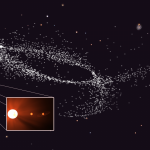W. M. Keck Observatory press release…
An international team of scientists, led by astronomers at Queen Mary University of London, report of two new planets orbiting Kapteyn’s star, one of the oldest stars found near the Sun. One of the newly-discovered planets could be ripe for life as it orbits at the right distance to the star to allow liquid water on its surface. The paper is being published by the Monthly Notices of the Royal Astronomical Society on June 4.

The astronomers used new data from the 3.6 meter La Silla Observatory in Chile to measure tiny periodic changes in the motion of the star, and followed up with two more high-precision spectrometers to secure the detection: W. M. Keck Observatory’s HIRES instrument installed on the 10-meter Keck I telescope on the summit of Mauna Kea, and PFS at the 6.5 meter Las Campanas Observatory in Chile.
Using the Doppler Effect, which shifts the star’s light spectrum depending on its velocity, the scientists can work out some properties of these planets, such as their masses and periods of orbit.
“We were surprised to find planets orbiting Kapteyn’s star,” said Dr Guillem Anglada-Escude, from QMUL’s School of Physics and Astronomy. “Previous data showed some moderate excess of variability, so we were looking for very short period planets when the new signals showed up loud and clear.”
“Paul Butler and I have been obtaining precision radial velocity data of Kapteyn’s star for over a decade at Keck, and were thus heavily invested in this work,” said Steve Vogt, a professor of astronomy at the University of California, Santa Cruz that contributed the data from Keck Observatory. “This quite southerly star was quite a tough stretch though from Keck, as the star never gets higher than 26 degrees altitude. Fortunately, Mauna Kea has excellent seeing and a clear view all the way to the southern horizon.”
“The discovery of planets around this star are the hard-won fruit of many years of patient, careful acquisition of high precision data from the very stable HIRES instrument on Keck,” said Paul Butler, astronomer with Carnegie Institution for Science that works with Vogt. “Our success was also due, in no small part, to the efforts of the excellent Keck staff that keep this complex facility finely-tuned year in and year out.”
Based on the data collected, the planet Kapteyn b might support liquid water as its mass is at least five times that of Earth’s and orbits the star every 48 days. The second planet, Kapteyn c is a massive super-Earth in comparison: its year lasts for 121 days and astronomers think it’s too cold to support liquid water.
At the moment, only a few properties of the planets are known: approximate masses, orbital periods, and distances to the star. By measuring the atmosphere of these planets with next-generation instruments, scientists will try to find out whether they can support liquid water.
Typical planetary systems detected by NASA’s Kepler mission are hundreds of light-years away. In contrast, Kapteyn’s star is only 13 light years away from Earth and is the 25th nearest star to the Sun.
Kapteyn’s star was born in a dwarf galaxy absorbed and disrupted by the early Milky Way. This galactic disruption event put the star in its fast halo orbit. The likely remnant core of the original dwarf galaxy is Omega Centauri, an enigmatic globular cluster 16,000 light years from Earth which contains hundreds of thousands of similarly old suns. This sets the most likely age of the planets at 11.5 billion years, which is 2.5 times older than Earth and 2 billion years younger than the universe itself (around 13.7 billion years).
“It does make you wonder what kind of life could have evolved on those planets over such a long time,” Anglada-Escude said.
“This discovery is very exciting,” said Professor Richard Nelson, Head of the Astronomy Unit at QMUL, who didn’t participate in the research. “It suggests that many potentially habitable worlds will be found in the next years around nearby stars by ground-based and space-based observatories, such as PLATO. Until we have detected a larger number of them, the properties and possible habitability of the near-most planetary systems will remain mysterious.”


Does this still exist physically or just in reflected light in route to Earth? How would you be able to make an educated guess with something so old…A planet long dead, or perhaps evolved over and over again over time,..?
Kapteyn’s star is only 13 light years away, that is pretty close in stellar terms. Thus we are detecting these planets as they were only 13 years ago. Red dwarf stars can last hundreds of billions of years, they are quite miserly in their usage of hydrogen fuel. Yes, this system is still around, and will be long after our Sun has become a white dwarf.